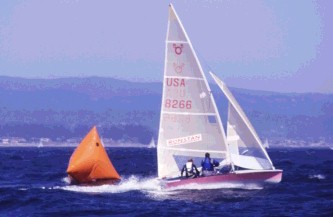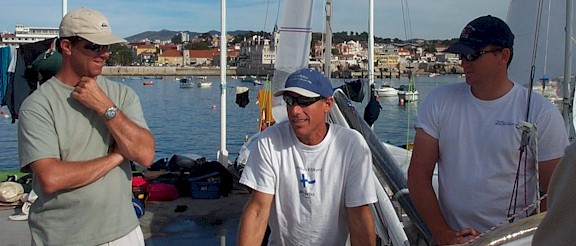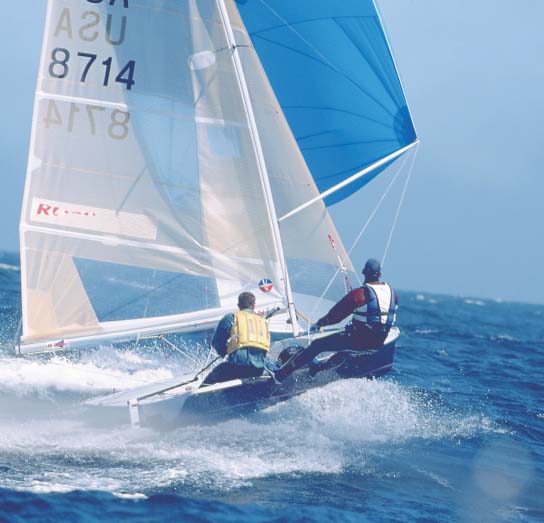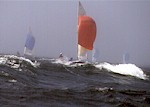L E S S O N S from Long Beach |
|
In 1979, Dan Thompson placed third at the Durban worlds. Two years later, he got out of the class entirely. There was the family to tend to, the demanding wife and two children in diapers. "It was a married with children type story, "he says. "With young children, it was hard to make it work in the 505 fleet. "He raced keel boats for a while, even won the Etchells North Americans.
He took up bicycle racing. Then in 1995, his kids all but grown and his marriage on the rocks, Thompson got a call from Howard Hamlin. "Howie calls me and says let’s go sailing, "says Thompson.

Howie Hamlin/Peter Alarie
at the 2000 North Americans, Santa Cruz.
Thompson had always thought about sailing the 505 again, but did little about it. It was Hamlin who provided the spark. He hooked Thompson up with boats and crews. He followed up with phone calls and gentle prodding. This August, Thompson placed fourth at the ultra-competitive North Americans. He is gearing up to return to Durban for the worlds this November. He and crew Andy Zinn (another Hamlin recruit) have a strong shot at a top ten finish.. Asked if he would have returned to the class without Hamlin’s intervention, Thompson says matter of factly, "Not a chance."

Dan Thompson, Howard Hamlin and Andy Zinn
With top recruits like Dan Thompson, Howard Hamlin has built his Long Beach-based fleet into the most competitive in North America. Team Hamlin counted three boats in the top five at this year’s North Americans, and could put as many in the top five at the Durban worlds. The pillars of the Hamlin program are super rigorous Tuesday night practice session and, most of all, a recruit-the-best philosophy. Given the success, we could all learn from Hamlin’s approach to fleet building. But the lesson from Long Beach turns out to be more complicated than it might seem.
Trial and Error
About a year before he called Thompson, Hamlin had a conversation with his crew, Mike Martin. He told Martin that he wanted to win the worlds. Martin laughed and pointed out that Hamlin had some work to do. For one thing, he never practiced. And even if he decided to start, there was no one to practice against. The Long Beach fleet consisted of one team, Hamlin and Martin."The original goal was to win the worlds so we decided that we couldn’t do that without people to practice against," said Martin. "So we decided we needed a fleet in Long Beach to sail against."
That first year,the pair got busy. They took the round-up-the-cattle approach. They held regattas where they’d match up new recruits to skippers and crews. They’d look for anyone they could. But they found that after a year they were not getting results and were no closer to winning the worlds. In fact, Martin recalls, the recruitment drive netted few real prospects and proved such a distraction that it probably hurt their performance at the 1995 worlds. "We saw our performance actually go down," he says.It was time for a new approach. And that meant targeting the boat to a different clientele, skilled sailors whose experience and build were suited to the class. Hamlin said he has learned an important lesson about fleet building. The less skilled sailors get in, get frustrated and drop out. That’s a big time waster for all concerned. The ideal recruit sticks around and is good enough to push the old timers to get better. He doesn’t mince words in criticizing those in the class who favor talking up the boat to "every Tom, Dick and Harry."
"To spend your energy on them is foolish, "he says. "Spend your time on people who have potential."
A case in point is the Long Beach team of Andy Beekman and Ben Benjamin. Martin and Hamlin pushed hard to get them in the class. Beekman was a graduate of the super-competitive Longhorn Yacht Racing Association junior program in Texas. And Hamlin and Martin were particularly impressed with the 26-year-old Beekman’s speed down-wind, an area that the fleet leaders knew they wanted to work at improving.
They sold Martin’s boat to the team for "under market value. "Said Beekman, "They basically brought me into the club. Howard’s mentality about it is get someone in the fleet who is going to stay and push him."
Getting Results
Since their initial conversation back in 1994, Hamlin and Martin had seemed to be getting ever close to their goal of winning the worlds. They had a near miss in 1998, finishing second behind Mike Mills and Nick Trotman. The following year in France, they finally captured the top spot in a demonstration of superior speed and boat handling. Right behind them in second place was team Beekman and Benjamin.So how’d they do it? Having built a small, stable fleet of expert sailors, Hamlin and Martin had put in place the second major element of their worlds program, a rigorous practice and tuning program. Before the 1997 North Americans, the Long Beach team began practicing regularly on Tuesday nights during daylight savings time and have kept at it. They’ll go out at about 5 p.m. and compare straight linespeed and work on technique on all legs of the course. They’ll sail for three minutes on one tack, stop and talk over who was doing what.
Hamlin said there is no question that the practice sessions have made a big difference in his performance. By his count, he used to sail 25 to 30 days a year. Under his current regime, he sails on 75 days. Beekman said the program is probably one of the best in the world. "When you get off the line and two minutes later you are sailing against the same people you are sailing against every Tuesday night something is going on, "says Beekman. "It is all about practice."
The key to the program is that Hamlin calibrates the boats so that they are exactly the same. All the boats are Waterats and Hamlins with launchers and Ullman sails. And each team sails with an identical set of numbers for such items as rig tension, board height and ram. That means, for example, that when Hamlin says that his board was set at two in 20 knots everyone in Long Beach knows exactly what he is talking about and can replicate the setting.Each of the teams sails with a tuning grid developed by Howie for all the key settings for different wind speeds. Thompson said the tuning sheet provides an important baseline. Whenever they are off the pace, they go back to the tuningsheet to make sure they’re sailing with the right adjustments. A common calibration system is also a vital fleet building tool because it creates a system for everyone to follow, making it easier for middle to back of the fleet boats to get up the learning curve.
In addition, the Long Beach sailors hold to team approach. That means that they try to share everything. They have frequent on the water conversations, spending a lot of phone time comparing notes and keep in close contact at regattas. At the North Americans, Hamlin and crew Peter Alarie noticed that Martin and crew Steve Bourdow (Martin is sailing his own boat this year) were sailing too low on the runs. They let Martin know, even though the two were battling it out for first place.

Mike Martin and Steve Bourdow, winner sof the 2000 NA's,
in Santa Cruz.
Rob Waterman is one member of Team Tuesday who has yet to be afforded rock star status. He placed a solid 12th at the NAs with a skipper who had sailed in the boat only a handful of times. He credits the Hamlin program with speed gains. He crews and can often hook up with driver and, armed with tuning information from the Tuesday night sessions, push the boat around the race course with considerable success. "While I don’t go to the worlds, I gain a hell of a lot out of the deal, "he says.
Lessons Learned
The question is whether the rest of us can learn just as much from the boys from Long Beach. There is no doubt that Hamlin has constructed a world class program for developing world class champions. And he makes a point of noting that anyone is welcome on Tuesday nights. "We don’t discourage anyone to come sail the 505, "he says."You can’t extend your professional career
and sail as hard as we do, "Beekman says.Beekman said the goal at Long Beach is for all of the teams to win the worlds. But how practical is the program for sailors who don’t share the passion? The Hamlin program does not come without sacrifice. For Beekman, that has meant throttling back on his career goals and making sure that his boss knows that he’s got to leave early on Tuesday afternoon to go sailing. "You can’t do both, "he says. "You can’t extend your professional career and sail as hard as we do."
Waterman agreed, "I think the Tuesday night thing is for people who are really gung ho, who have a fair amount of time in the boat or money. The rest of us poor slobs have kids and wives."Martin argued that fleet building is about setting priorities. Every fleet needs to figure out what approach works best for them. The number of active boats at Long Beach, five, is close to ideal for training program.
But that hardly works for building strong numbers at regattas. If everyone had embraced Hamlin’s approach, it seems likely that the turnout at this year’s 45 boat NAs would have been considerable lower.
The answer is taking away the right lessons. For example, Hamlin’s calibration system is an ideal tool for making any sailor better, no matter what his status. Martin says go out an set up a practice session that works for you. It doesn’t necessarily have to be along the lines of Team Tuesday. "Everybody has got to target their fleet building to their fleet,"says Martin." If your driving force is not to win the worlds but to get 20 boats on the line then you are going to have a different fleet building approach."
No matter the limits of the approach, Thompson gives Howie plenty of credit for building a world class program that is an engine for fleet growth. "Howard has tried it all different ways. He has tried bringing the general masses in. He has tried bringing in the super sailor. I think what we have learned so far is that if you recruit the better sailors in the class the others will follow. But you have to make it fun for the other sailors. Howard does that. He goes around and calibrates everybody’s boat. He does the debriefs after every race. He makes people feel like they’re part of the community."
|
This article as: PDF Document |
||
|
||
TANK TALK - FALL 2000

